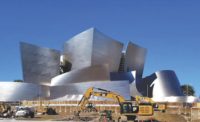Eight years into its pier 400 land reclamation and container terminal project, the Port of Los Angeles' first ship is about to come in. The world's largest container terminal will berth its first vessel this month, just 20 months after work began on the $343-million first phase. By meeting or beating deadlines, contractors will avoid liquidated damages of $61,000 a day, says Stacey G. Jones, chief harbor engineer.
 |
| Port of Call: Los Angeles Port is building world's largest container terminal (Photo: courtesy of The Port of Los Angeles) |
The 343-acre first phase sits on a $350-million, 590-acre landfill dredged and reclaimed between 1994 and 2000 in Los Angeles Harbor by a joint venture of Great Lakes Dredge & Dock Co., Oakbrook, Ill., and Connolly Pacific Co., Long Beach, Calif. The $2.4-billion, 20-mile Alameda Corridor, which opened this spring, will link the terminal to the transcontinental freight rail network (ENR 4/15 p. 21).
With a single 7,000-ft-long causeway providing the only land access, "we knew up front that access was going to be one of the primary concerns," says Jones. The port and six prime contractors used partnering and frequent meetings to plan critical deliveries and make the start-up date for eight major contracts, says Shaun Sharestani, the port's terminal project manager.
In the single largest contract, Anaheim-based Sully Miller Contracting Co. completed the 308-acre back land, the paved container storage area. To minimize earthquake liquefaction, contractors used compaction and stone columns, says Michael G. Gasparro, a vice president at Irvine, Calif.-based DMJM+Harris, the landfill design consultant in joint venture with Long Beach-based Moffatt & Nichol Engineers.
Working from 50% designs, Tutor-Saliba Corp., Sylmar, Calif., completed all 21 of the first phase's buildings under two design-build contracts totaling $52 million. Between January 2001 and April 2002, the Irvine, Calif. office of Traylor Pacific installed piles and deck for the 4,000-ft-long, $58.3-million wharf. The facility also includes a $28-million intermodal transfer facility built by Marta Metroplex and road and rail links to the mainland and nearby Terminal Island.
Hayward Baker Inc.'s Santa Paula, Calif., office installed stone columns about 8 ft on centers in a triangular grid extending about 25 ft beyond the footprints of three key buildings, Gasparro says. For other buildings, crews compacted fill by dropping a 27-ton weight from 80 ft, then pouring a concrete mat foundation slab. Hayward Baker also placed columns in an 80-ft-deep, 4,000-ft-long swath behind the wharf edge, says Steve Reiser, Traylor Pacific's project manager.
Pile-driving came right after column installation near the wharf. The 2,200 24-in.-dia piles, ranging from 55 ft to 124 ft long, were driven through the rock dike surrounding the fill, but shifted, requiring in-house engineers to modify the formwork design.
The $140-million second phase is slated to start construction in November. When completed in 2004, the terminal, owned by Danish shipping giant Maersk Sealand, will cover 484 acres.




Post a comment to this article
Report Abusive Comment